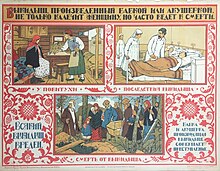Self-Induced Abortion


A self-induced abortion (also called a self-managed abortion, or sometimes a self-induced miscarriage) is an abortion performed by the pregnant person themselves or with the help of other, non-medical assistance. Although the term includes abortions induced outside of a clinical setting with legal, sometimes over-the-counter medication, it also refers to efforts to terminate a pregnancy through alternative, potentially more dangerous methods. Such practices may present a threat to the health of women.
Self-induced (or self-managed) abortion is often attempted during the beginning of pregnancy (the first eight weeks from the last menstrual period). In recent years, significant reductions in maternal death and injury resulting from self-induced abortions have been attributed to the increasing availability of misoprostol (known commercially as "Cytotec"). This medication is a synthetic prostaglandin E1 that is inexpensive, widely available, and has multiple uses, including the treatment of post-partum hemorrhage, stomach ulcers, cervical preparation and induction of labor. The World Health Organization (WHO) has endorsed two regimens for abortion up to 12 weeks of pregnancy using misoprostol: a standardized regimen of mifepristone and misoprostol and a regimen of misoprostol alone. The regimen with misoprostol alone has been shown to be up to 83% effective in terminating a pregnancy but is more effective combined with mifepristone.
Methods attempted
Women can use many different methods to self-manage (or self-induce) an abortion. Some are safe and effective, while others are dangerous to the health of the woman and/or ineffective at terminating a pregnancy.
Mifepristone and/or misoprostol
The only scientifically studied effective self-induced abortion method is ingesting a combination of mifepristone and misoprostol or misoprostol alone. The combination of these medications is on the World Health Organization's List of Essential Medicines, the safest and most effective medicines needed in a health system. In some countries, these pills may be available over-the-counter in pharmacies, although some pharmacists do not provide accurate instructions on use. In Latin America, women have reported self-inducing abortions with misoprostol alone since the 1980s. The history of women self-managing abortion with pills includes projects such as the Socorristas in Argentina and Las Libres in Mexico. Other countries have "safe abortion hotlines", which facilitate access to pills, provide instructions on proper use of the pills, and provide emotional, logistical, and/or financial support. Some women use online abortion pill help services such as Women on Web and Aid Access to order mifepristone and/or misoprostol, with reported effectiveness and safety in pregnancy termination and satisfaction in the service. Instructions on abortion pill use are widely available on the websites of the World Health Organization (WHO), Gynuity Health Projects, and the International Women's Health Coalition.
First trimester medical abortion is highly safe and effective. The side effects of medication abortion include uterine cramping and prolonged bleeding, and common side effects include nausea, vomiting and diarrhea. The majority of women who use abortion pills on their own do not need an ultrasound or a clinician, although one may be recommended to ensure that the pregnancy is not ectopic. In the rare case of a complication, a woman can access a clinician skilled in miscarriage management, which is available in all countries.
Studies confirm a correlation between the increase in the self-administration of medical abortion with misoprostol, and a reduction in maternal morbidity and mortality. Some studies argue that unfettered access to medication abortion is a key tenet of public health, human rights, and reproductive rights.
Physical trauma, herbs, and other substances
Self-induced abortion methods vary around the world. The most commonly recorded are ingestion of plants or herbs, ingesting toxic substances, causing trauma to the uterus, causing physical trauma to the body, using alcohol and drugs in an attempt to end the pregnancy, and ingesting other substances and mixtures. There are no known effectiveness studies for plants, herbs, drugs, alcohol, or other substances. These methods are more likely to cause bodily harm to the pregnant woman than to be effective in terminating a pregnancy. Causing physical trauma to a woman's body or uterus may also result in physical harm or even death to the woman instead of causing an abortion.
Rates
As of 2019[update], an estimated fifty-six million abortions occurred worldwide, of which twenty-five million are less safe or least safe. Induced abortion is medically safe when WHO recommended methods are used by trained persons, less safe when only one of those two criteria is met, and least safe when neither is met. Self-induced abortions can be safe or unsafe depending on the methods used.
It is difficult to measure the prevalence or rate of self-induced abortions. As of 2018[update], in the United States, the estimate was that one in 10 abortions is self-induced. While maternal morbidity and mortality from unsafe abortion has continued to increase due to population growth, in Latin America, from 2005 to 2012, there was a 31% decrease in the number of complications from unsafe abortion, from 7.7/1,000 to 5.3/1,000. Researchers believe that this may be due to the wide availability of misoprostol in Latin America. In late 2019, it was reported that rates of self-induced abortion in the United States were rising, partly due to fears that more conservative policies would limit access to clinical abortion, and partly due to the increased availability and convenience of telehealth medical supervision and prescriptions and mail-order drugs.
History
The practice of attempted self-induced abortion has long been recorded in the United States. Turn-of-the-20th-century birth control advocate Margaret Sanger wrote in her autobiography of a 1912 incident in which she was summoned to treat a woman who had nearly died from such an attempt.

In a letter to The New York Times, gynecologist Waldo L. Fielding wrote:
The familiar symbol of illegal abortion is the infamous "coat hanger" — which may be the symbol, but is in no way a myth. In my years in New York, several women arrived with a hanger still in place. Whoever put it in – perhaps the patient herself – found it trapped in the cervix and could not remove it...However, not simply coat hangers were used. Almost any implement you can imagine had been and was used to start an abortion – darning needles, crochet hooks, cut-glass salt shakers, soda bottles, sometimes intact, sometimes with the top broken off.
Charles Jewett wrote The Practice of Obstetrics in 1901. In it, he stated, "Oil of tansy and oil of rue are much relied on by the laity for the production of abortion, and almost every day one may read of fatal results attending their use. Oil of tansy in large doses is said to excite epileptiform convulsions; quite recently one of my colleagues met such a case in his practice."
In the 1994 documentary Motherless: A Legacy of Loss from Illegal Abortion, Louis Gerstley, M.D., said that, in addition to knitting needles, some women would use the spokes of bicycle wheels or umbrellas. "Anything that was metal and long and thin would be used," he claimed. He stated that a common complication from such a procedure was that the object would puncture through the uterus and injure the intestines, and the women would subsequently die from peritonitis and infection. Later in the film he mentioned that potassium permanganate tablets were sometimes used. The tablets were inserted into the vagina where they caused a chemical burn so intense that a hole may be left in the tissue. He claimed the tablets left the surrounding tissue in such a state that doctors trying to stitch up the wound couldn't do so because "the tissue was like trying to suture butter." Dr. Mildred Hanson also described the use of potassium permanganate tablets in the 2003 documentary Voices of Choice: Physicians Who Provided Abortions Before Roe v. Wade. She said, "the women would bleed like crazy because it would just eat big holes in the vagina."
Dr. David Reuben mentions that many African women use a carved wooden "abortion stick" to induce, which has often been handed down.
A study concluded in 1968 determined that over 500,000 illegal abortions were performed every year in the United States, a portion of which were performed by women acting alone. The study suggested that the number of women dying as a result of self-induced abortions exceeded those resulting from abortions performed by another person. A 1979 study noted that many women who required hospitalization following self-induced abortion attempts were admitted under the pretext of having had a miscarriage or spontaneous abortion.
WHO estimates that approximately 25 million abortions continue to be performed unsafely each year. Around 7 million women are admitted to hospitals every year in developing countries and between 4.7% – 13.2% of all maternal deaths can be attributed to unsafe abortion. Almost every one of these deaths and disabilities could have been prevented through sexual education, family planning, and the provision of safe abortion services. Abortion pills, which were first used by Brazilian women in the 1980s, can prevent many of these deaths from unsafe abortion.
Law
United States
In the United States, experts report that self-induced abortion can be medically safe but legally risky. The 1973 Supreme Court decision Roe v. Wade made abortion more readily available throughout the U.S., yet women who have abortions with pills ordered online or through non-clinical means may face risk of arrest. Under federal law in the United States, a person has a constitutional right to an abortion and there are not statutes that ban a person from managing their own abortion.
It is not common for women in the United States to be charged for the crime of self-inducing an abortion and they are rarely convicted. However, a small number of people in the U.S. have been arrested for ending their own pregnancies with pills ordered online, including Purvi Patel, Jennie Linn McCormack, and Kenlissia Jones. These women were prosecuted under a variety of laws including: laws directly criminalizing self-induced abortions, laws criminalizing harm to fetuses, criminal abortion laws misapplied to people who self-induce, and various laws deployed when no other legal authorization could be found. The non-profit If/When/How: Lawyering for Reproductive Justice works to change laws and policies than prevent people from managing their own abortion using a reproductive justice framework. The non-profit Plan C envisions a world in which the ability to end a pregnancy is in the hands of the person who needs it. Plan C issues a report card on sites that sell pills used to induce an abortion, rating them on price, shipping time, quality, and physician oversight.
As of 2019, there are seven states with laws directly criminalizing self-induced abortion, 11 states with laws criminalizing harm to fetuses that lack adequate exemptions for the pregnant woman, and 15 states with criminal abortion laws that could be applied to women who self-induce an abortion. Both the National Lawyers Guild and the American Medical Association passed resolutions condemning the criminalization of self-induced abortion.
See also
- Abortion debate
- Feminist Abortion Network
- Gerri Santoro
- Menstrual extraction
- Our Bodies, Ourselves
- Reproductive rights
- Unsafe abortion